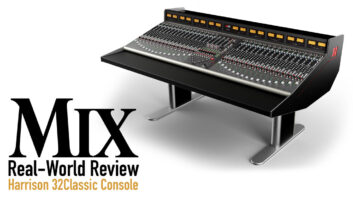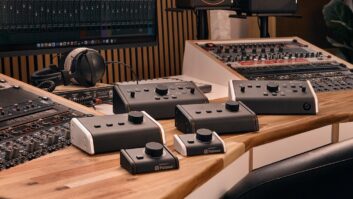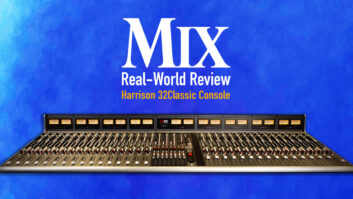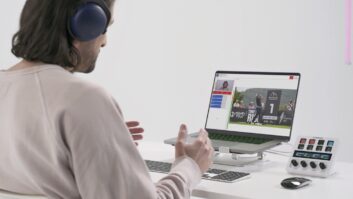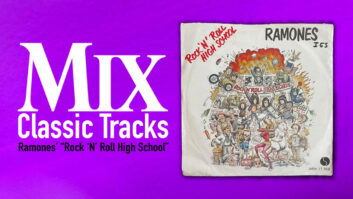When the Chips Are Down
I have always enjoyed reading your magazine and reading about new products and technologies. Especially interesting to me are the reviews and articles on tube-based equipment. I have been a “filament head” for years and love the fact that tubes have made a comeback. However, your review of the TL Audio VTC console (July 2001 “Field Test”) prompted me to write to you and your readers.
According to the review, the console uses an SSM2017 chip in the preamp before it continues on to the tube stages. The SSM chip has been discontinued by the manufacturer Analog Devices, and to the best of my knowledge there is no available substitute pin, compatible or otherwise. One of my clients has a DDA console that uses the same chip in the preamp, and he has been having problems with chip failure and difficulty in obtaining spares. I question the wisdom of using this chip and wonder what purchasers of the TL console will do when their chips start failing down the road. If there were a substitute, I would be very interested in finding out about it.
Brit Fader
President, Brit Fader Amps
More on SAN
I am writing regarding Gerald Robinson’s “The Price of Fiber” letter (October 2001 “Feedback”) and his comment, “I find the assertion by Ed Bacorn [of Glyph Technologies] that ‘Ethernet is very high overhead,’ and slow to be silly.” I don’t quite understand his misgivings. The original article, “Wired for Data — Audio Collaboration in the Network Age” in the June Mix, offered options for digital audio. One option was Storage Area Networking, which I was doing for Glyph at the time. I now build SAN for A/V for JEMS Data Unlimited (www.jemsdata.com) with the same resolve and understanding of networks in a pro environment.
In the Mix article, I was asked about how a SAN would work as opposed to other solutions in a pro audio environment. As a SAN specialist for six years, I naturally defended my turf. Mr. Robinson seems to think some of the data given was inaccurate and hoped to expand my knowledge with a Seagate Website. I, too, have a URL for him to peruse: Visit www.brocade.com/san/white_papers.jhtml and read “Fibre Channel and Ethernet: Different Approaches Meet Different Computing Needs.” He may find it enlightening and develop more tolerance for us poor SAN guys who spend time answering the question, “Why can’t we just all work on Ethernet?”
As to the high cost of Fibre, I was referring to Fibre Channel as a solution and not fiber (note the spelling), the cable. I agree that fiber-optic cable is roughly the same cost as Cat 5 or similar cable solutions. Also, the comment regarding EMC and STK running hybrid solutions over Ethernet and Fibre Channel is right on the money. Avid runs Avid Unity over both solutions. The Ethernet handles the metadata (information about the information), while the Fibre Channel handles the bulk transactions or A/V files. The downside is its cost and limited availability in an audio environment.
I should address the comment about not requiring a fabric switch for SANs below five workstations. In a non-pro environment, an FC Hub may be used. These are relatively inexpensive, yet not recommended when fault tolerance and stability are required. If your customer runs five workstations and one crashes, which occasionally happens, this results in Loop Initialization Protocol. Essentially, all traffic on the network stops momentarily in order to re-assign addresses to each workstation and each drive on the network. This typically takes several seconds. If editors are running AVR 77 or multitrack sessions when this occurs, then they’ll experience an interrupt or just hang altogether. In a pro environment, this is not a solution. This common issue plagued the FC industry until the advent of fabric switches.
All said, I believe we’re not too far apart with our views on why Ethernets and SANs should be considered for a shared environment. In many cases, both can and should be utilized.
Ed Bacorn
JEMS Data Unlimited
Production Music Realities
Keep on reviewing production music libraries. Ken Jacobs (November “Feedback”) seems to think that using “canned” music is a production sin. Get real Ken. The only sin some producers commit is using some bad production music, and there is plenty of it out there.
For someone to think that they have to, or should, record music for every production is ridiculous and naive.
I produce about 80 radio spots a month, and probably five or 10 TV audio tracks in my studio. If I had to call the writers and musicians every time I wanted to produce a spot or TV commercial, I’d be out of business. My clients couldn’t afford it, nor would they have the time for me to finish the productions.
Regarding libraries, I’d say 80% of the production music out there isn’t too good. You have to be selective. But the 20% that is good is an asset and a valuable tool to the production business.
If Mr. Jacobs is so gung ho to create original music, he should consider starting a production library himself. Then he can record original music all day and keep his studio busy.
Tom Snyder
Tom Snyder Advertising Productions
Fort Lauderdale, Fla.
Paying To Play
I’ve just finished reading your article in the September 2001 issue (“Insider Audio: Living on Borrowed Culture”). It is very timely and well spoken. I must say that I have seen this trend developing over quite a stretch of time.
I graduated high school in a Detroit suburb in 1984, and at that time all of the fiscal bosses were beginning to cut expenditures in education, causing turmoil in all of the arts programs, as well as for athletics.
As far as I know, there now exists in the high school I graduated from a “pay to play” system, with which I’m sure you are familiar. This is an abomination. We have public school systems across our country that preach about a “well-rounded education,” but eliminate these fundamentals. Anyway, thanks for a great article. I hope it makes some difference.
Steve Fritz
Garden City, Mich.
Send Feedback to Mix via e-mail[email protected]or write to Mix
6400 Hollis Street, Suite 12
Emeryville, CA 94608
